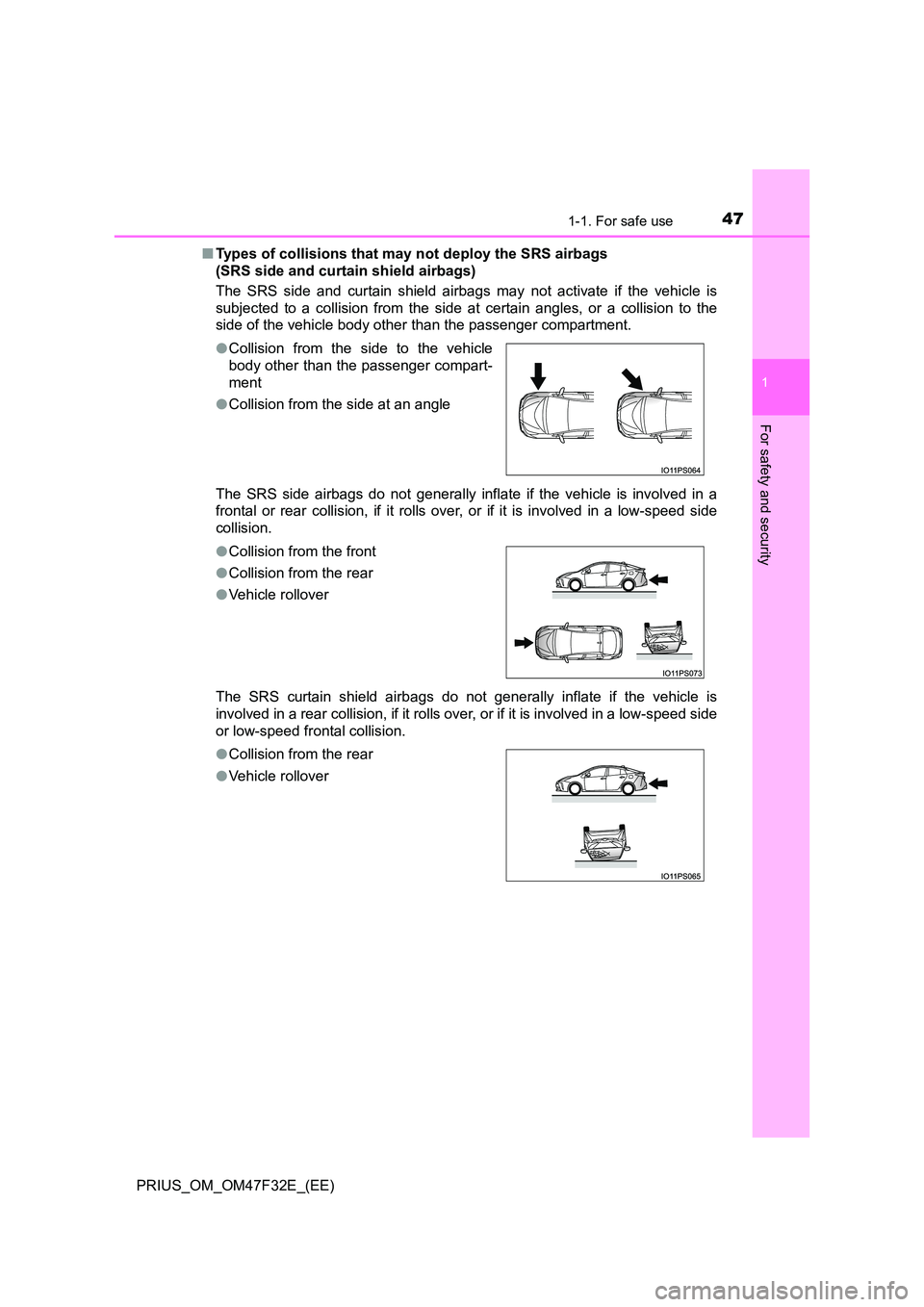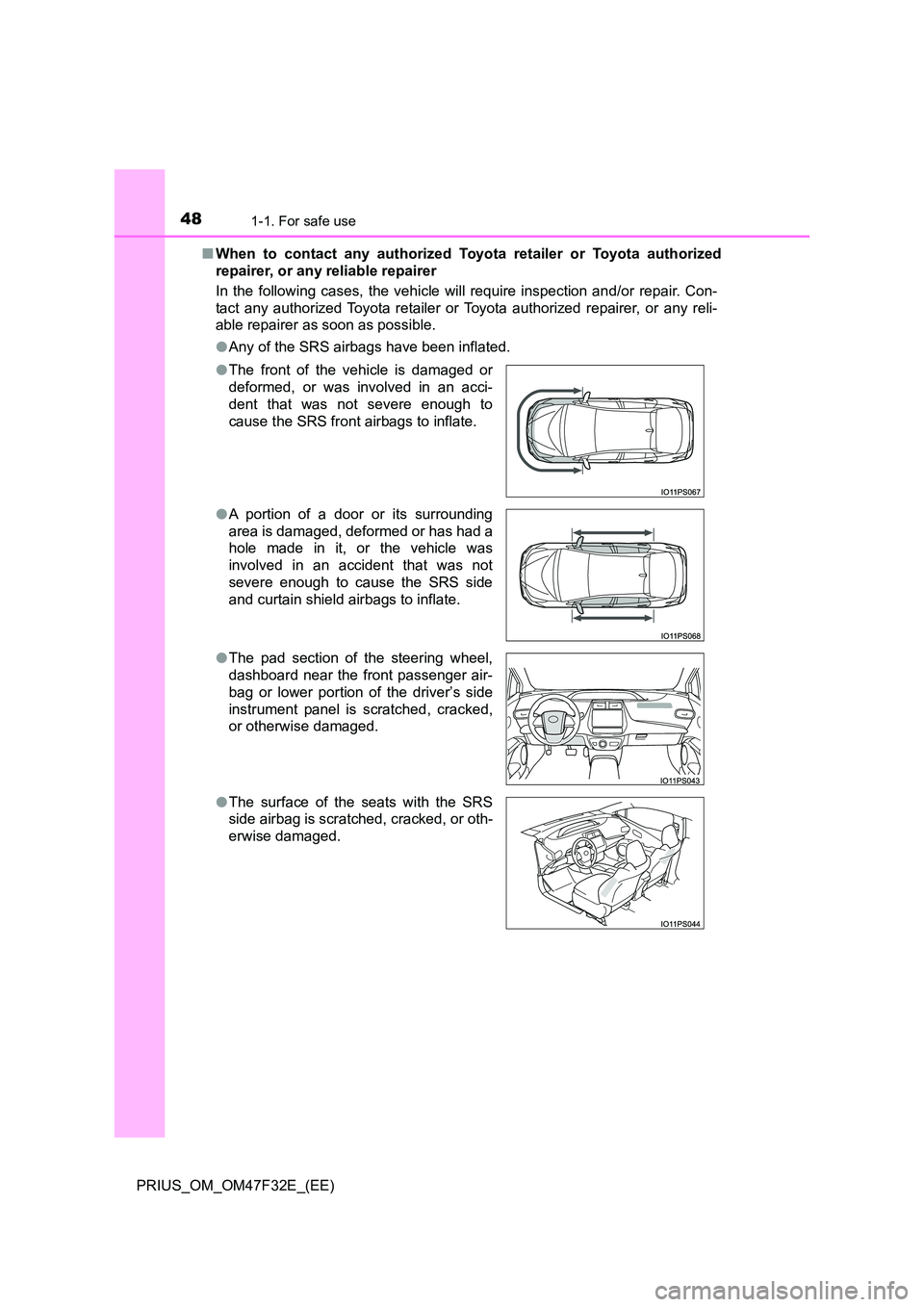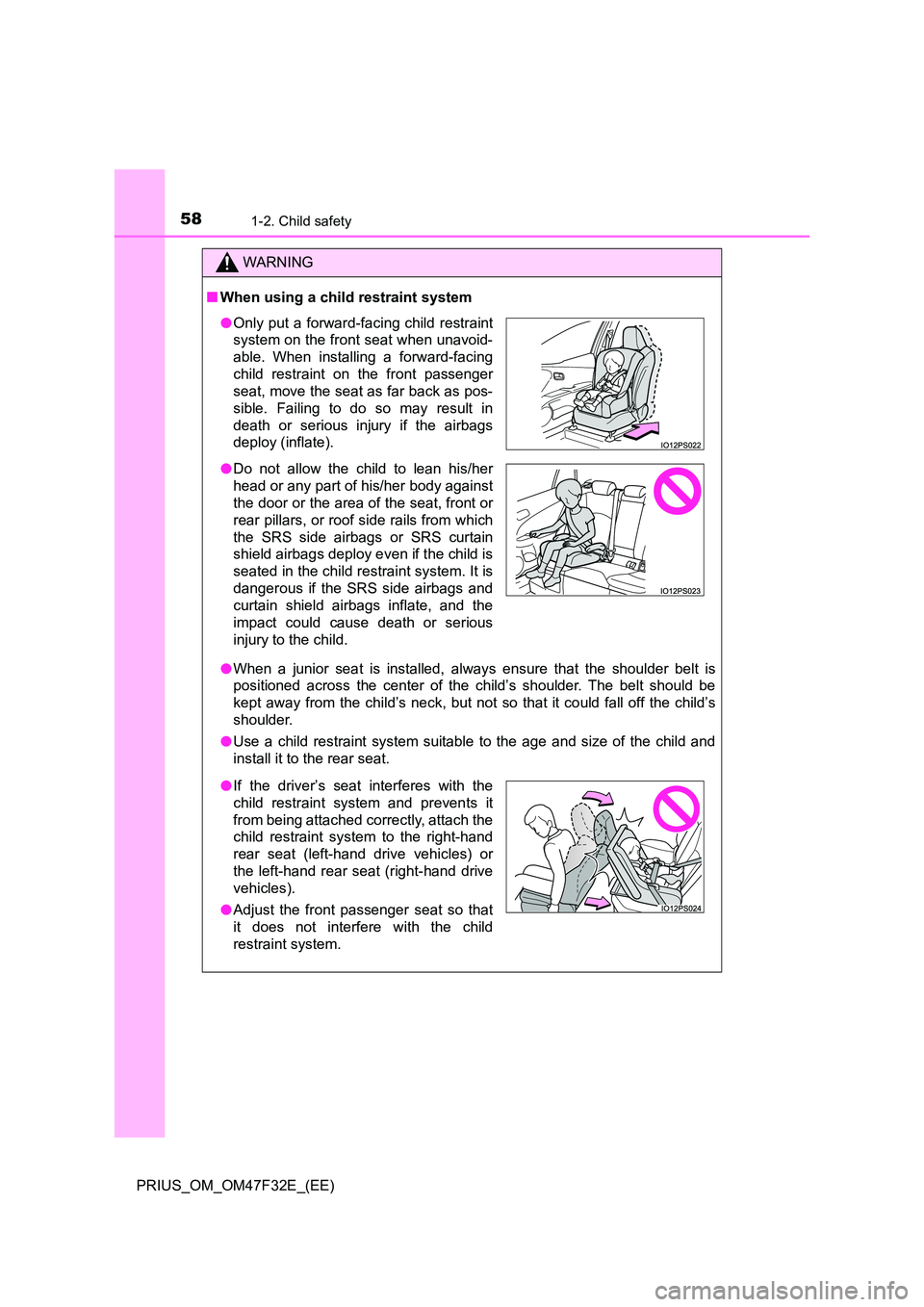Page 49 of 770

471-1. For safe use
1
PRIUS_OM_OM47F32E_(EE)
For safety and security
■Types of collisions that may not deploy the SRS airbags
(SRS side and curtain shield airbags)
The SRS side and curtain shield airbags may not activate if the vehicle is
subjected to a collision from the side at certain angles, or a collision to the
side of the vehicle body other than the passenger compartment.
The SRS side airbags do not generally inflate if the vehicle is involved in a
frontal or rear collision, if it rolls ov er, or if it is involved in a low-speed side
collision.
The SRS curtain shield airbags do not generally inflate if the vehicle is
involved in a rear collision, if it rolls over, or if it is involved in a low-speed side
or low-speed frontal collision.
● Collision from the side to the vehicle
body other than the passenger compart-
ment
● Collision from the side at an angle
● Collision from the front
● Collision from the rear
● Vehicle rollover
● Collision from the rear
● Vehicle rollover
Page 50 of 770

481-1. For safe use
PRIUS_OM_OM47F32E_(EE)
■ When to contact any authorized Toyota retailer or Toyota authorized
repairer, or any reliable repairer
In the following cases, the vehicle will require inspection and/or repair. Con-
tact any authorized Toyota retailer or Toyota authorized repairer, or any reli-
able repairer as soon as possible.
● Any of the SRS airbags have been inflated.
● The front of the vehicle is damaged or
deformed, or was involved in an acci-
dent that was not severe enough to
cause the SRS front airbags to inflate.
● A portion of a door or its surrounding
area is damaged, deformed or has had a
hole made in it, or the vehicle was
involved in an accident that was not
severe enough to cause the SRS side
and curtain shield airbags to inflate.
● The pad section of the steering wheel,
dashboard near the front passenger air-
bag or lower portion of the driver’s side
instrument panel is scratched, cracked,
or otherwise damaged.
● The surface of the seats with the SRS
side airbag is scratched, cracked, or oth-
erwise damaged.
Page 53 of 770
511-2. Child safety
1
For safety and security
PRIUS_OM_OM47F32E_(EE)
Airbag manual on-off system
“PASSENGER AIR BAG” indi-
cator
The “ON” indicator light turns on
when the airbag system is on, and
about after 60 seconds it goes off.
(only when the power switch is in
ON mode).
Airbag manual on-off switch
This system deactivates the front passenger airbag.
Only deactivate the airbag when using a child restraint system
on the front passenger seat.
1
2
Page 54 of 770

521-2. Child safety
PRIUS_OM_OM47F32E_(EE)
Insert the mechanical key into the
cylinder and turn to the “OFF”
position.
The “OFF” indicator light turns on
(only when the power switch is in
ON mode).
■ “PASSENGER AIR BAG” indicator information
If any of the following problems occur, it is possible that there is a malfunction
in the system. Have the vehicle inspected by any authorized Toyota retailer or
Toyota authorized repairer, or any reliable repairer.
● The “OFF” indicator does not illuminate when the airbag manual on-off
switch is set to “OFF”.
● The indicator light does not change when the airbag manual on-off switch is
switched to “ON” or “OFF”.
Deactivating the airbag for the front passenger
WARNING
■ When installing a child restraint system
For safety reasons, always install a child restraint system in a rear seat. In
the event that the rear seat cannot be used, the front seat can be used as
long as the airbag manual on-off system is set to “OFF”.
If the airbag manual on-off system is left on, the strong impact of the airbag
deployment (inflation) may cause serious injury or even death.
■ When a child restraint system is not installed on the front passenger
seat
Ensure that the airbag manual on-off system is set to “ON”.
If it is left off, the airbag will not deploy in the event of an accident, which
may result in serious injury or even death.
Page 59 of 770
571-2. Child safety
1
PRIUS_OM_OM47F32E_(EE)
For safety and security
WARNING
■When using a child restraint system
Observe the following precautions.
Failure to do so may result in death or serious injury.
● Never use a rear-facing child restraint
system on the front passenger seat
when the airbag manual on-off switch is
on. ( P. 51)
The force of the rapid inflation of the
front passenger airbag can cause death
or serious injury to children in the event
of an accident.
● There is a label(s) on the passenger
side sun visor, indicating it is forbidden
to attach a rear-facing child restraint
system to the front passenger seat.
Details of the label(s) are shown in the
illustration below.
Page 60 of 770

581-2. Child safety
PRIUS_OM_OM47F32E_(EE)
WARNING
■When using a child restraint system
● When a junior seat is installed, always ensure that the shoulder belt is
positioned across the center of the child’s shoulder. The belt should be
kept away from the child’s neck, but not so that it could fall off the child’s
shoulder.
● Use a child restraint system suitable to the age and size of the child and
install it to the rear seat.
● Only put a forward-facing child restraint
system on the front seat when unavoid-
able. When installing a forward-facing
child restraint on the front passenger
seat, move the seat as far back as pos-
sible. Failing to do so may result in
death or serious injury if the airbags
deploy (inflate).
● Do not allow the child to lean his/her
head or any part of his/her body against
the door or the area of the seat, front or
rear pillars, or roof side rails from which
the SRS side airbags or SRS curtain
shield airbags deploy even if the child is
seated in the child restraint system. It is
dangerous if the SRS side airbags and
curtain shield airbags inflate, and the
impact could cause death or serious
injury to the child.
● If the driver’s seat interferes with the
child restraint system and prevents it
from being attached correctly, attach the
child restraint system to the right-hand
rear seat (left-hand drive vehicles) or
the left-hand rear seat (right-hand drive
vehicles).
● Adjust the front passenger seat so that
it does not interfere with the child
restraint system.
Page 63 of 770
611-2. Child safety
1
PRIUS_OM_OM47F32E_(EE)
For safety and security
■Compatibility of each seating position with child restraint sys-
tems
Left-hand drive vehiclesRight-hand drive vehicles
Deactivation of front passenger airbag.
Activation of front passenger airbag.
Never use a rearward-facing child restraint system on the front
passenger seat when the airbag manual on-off switch is on.
Suitable for “universal” category child restraint system fixed with
the seat belt.
Suitable for forward-facing “universal” category child restraint sys-
tem fixed with the seat belt.
Suitable for recommended child restraint systems given on recom-
mended child restraint systems information ( P. 6 6 ) .
Suitable for i-Size and ISOFIX child restraint system.
Includes a top tether anchorage point.
Not suitable for child restraint system.
Page 66 of 770
641-2. Child safety
PRIUS_OM_OM47F32E_(EE)
■Detail information for child restraint systems installation
*: All universal categories (group 0, 0+, I, II and III).
Toyota suggests the users to use and seating positions.
Seating position
Seat position number
Airbag manual
on-off switch
ONOFF
Seating position suitable for univer-
sal belted (Yes/No)
Ye s
Forward-
facing
only
Ye s*Ye s*Ye s*
i-Size seating position (Yes/No) No No Yes Yes
Seating position suitable for lateral
fixture (L1/L2/No) No No No No
Suitable rearward facing fixture
(R1/R2X/R2/R3/No) No NoR1, R2X,
R2, R3
R1, R2X,
R2, R3
Suitable forward facing fixture
(F2X/F2/F3/No) No No F2X, F2,
F3
F2X, F2,
F3
Suitable junior seat fixture
(B2/B3/No) No No B2, B3 B2, B3